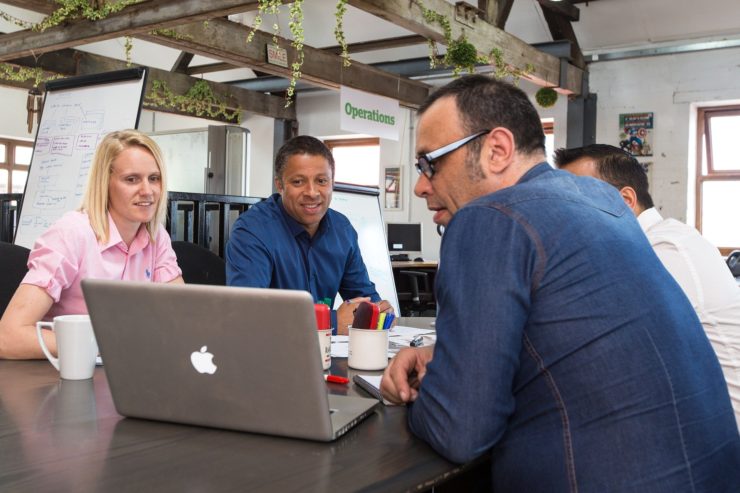OK, so you’re at the point where the client loved your proposal and wants to work with you (now that’s a great feeling!) They are sufficiently convinced of the many benefits of having a website for their business or nonprofit, and they’d love for you to create one for them. Your new client has placed their trust in YOU to create one of the most important parts of their online company brand.
How do you begin? You begin by picking your new client’s brain, in the hope that they will have answers for you. Sometimes they do and sometimes clients have no idea what they’re looking for in a website. In this case they will defer to your expert judgement. But at the bare minimum you will need to elicit some information from your client if you don’t want to waste a bunch of time and have the project turn into a disaster.
Read on for details on essential KEY questions that you should be asking in this situation.

Q. Are there any websites you can share with me that have a style you particularly like?
So far I have posed this question to every one of my clients, and have found their answers to be incredibly helpful. Seeing these sample websites tends to cover several bases all at once, and helps me to get an idea of what colors and font styles my client is leaning towards. It also clues me in to what type of CMS (content management system) theme or template to use as a starting point for their website.
Sometimes my client will also give me other important information such as “I really love how they used a popup form here” or “can I have a CTA (call-to-action) button, along the same lines as this website here?” This questions also usually brings out clues regarding the use of photography and graphics, and gives me a better idea of the vibe the customer is shooting for.
For a quick glance at some websites that are really outstanding, creative and unique — here are a few of our picks for most creative websites ever.
This doesn’t mean that it’s in any way acceptable to copy other websites or to plagiarize someone else’s designs – that’s never ok. What is ok however, is to use the websites you are shown as a jumping-off point, which you will then customize and make your own. If you don’t have a clue regarding your client’s aesthetic you can waste hours and hours (or even days), trying different themes, designs, fonts, and so on – only to have the client change their mind.
What I do is FIRST get a general idea of what website style to start with, THEN I find a theme that has a similar look/feel, or build it myself from scratch using some form of coding framework like Bootstrap or HTML5. Then LASTLY I customize the heck out of the theme by creating a child theme (if I’m working in WordPress), and adding custom coding and graphics to make it into something unique, special and one-of-a-kind.
Q. What is the main purpose of this website?
This question is a bit of a no-brainer … so much so that I often forget to ask it. Obviously nobody is going to pay you to build them a web website for no reason.
So let me rephrase the question to:
What exactly would you like people to do while they are on your website? What is the desired end result?
This answer might be harder than you think to draw out of your client, but it is so important to get this piece right.
You might need to ask your client if they are trying to get website visitors to …
- Book an appointment
- Download a free guide or e-Book
- Subscribe to a newsletter or email list
- Sign up for a course
- Register for an event
- Purchase a physical product
- Purchase a digital product
- Read their website or blog to become informed about a subject
- Learn about the programs, services or events that are being offered
- Become more involved in their community
- Learn about an important cause or social issue
Knowing the answer to this question will really help steer your website-creation process, because you’d know what kinds of items and CTAs to place emphasis on.
Q. How much of the content will you be providing? How much of it is ready now?
Ahhh the process of getting a client to give content to their web developer. Of all the challenges of freelancing, this one has got to be near the top of my list of frustrations. In my experience the way it usually works is like the following scenario:
1) client decides they don’t have the time, inclination or expertise to create their own site, so they hire you (woo hoo!)
2) client is excited and is ready to roll (“yeah!! I’m going to have an awesome website”)
3) you do your part and do all the necessary prep work to build the framework for the site, set up hosting and domain name, etc.
4) you ask the client to send you whatever content they have ready. They then proceed to send you about 4 paragraphs, which you eagerly paste into their website
5) then you wait and wait and wait for your client to send you the rest of the content, but because they have a business to run and are probably incredibly busy, they don’t have time to write up the necessary content and send it to you.

Yeah. So it’s pretty important to get the content-creation and delivery process ironed out as soon as you can. Will your client need help getting their text and photos and other content together? Probably. Just be aware of this going in and prepare accordingly.
If you do find yourself writing content (more than a sentence here and there) remember to charge accordingly!
Q. Do you have a general idea of a timeline, and of when you’d like to go live? Or do you have a hard deadline you need to meet?
I personally like to keep the deadline open-ended if my client happens to take my schedule into account (which they often do, thankfully!) As mentioned above, so much of the website-building process depends upon receiving content in a timely manner, from whoever I’m building a website for. If their content isn’t ready or only partially ready that could push out (and should push out) the end go-live date, sometimes by a span of months.
That being said, it is a good idea to have a broad, general idea of when to bring the project to completion and go live. My husband and I just finished up a large website project for a local nonprofit, where an estimated project time span of 5 months was initially agreed upon. Due to numerous delays – from lack of textual content, to vacations, to technical server issues – the website finally launched out to the public after 7 and ½ months.
The big lesson here is to always pad your timeline and schedule, and give the website creation process more time than you think you will need. Because trust me – you will need it.
Q. What are your future plans for this website?
Hopefully asking this question will elicit a response that includes plans to have you maintain the site once you’re done building it. If your client doesn’t offer this up as an option, don’t be afraid to sell your services a bit here and let them know you do website maintenance (if you’re interested in that sort of thing). For me it’s been pretty easy to tell if a client was interested in having me provide ongoing maintenance, since the ones that were just came out and asked me.
Other important details to try and glean during your conversations with your customers is their plans for marketing their newly created (or newly redesigned) website. Try to find out if they need SEO services and/or for you to set up their Google My Business account for them. You might be surprised at how many small business owners have never even heard of GMB, so this could be good opportunity for you to offer up a separate SEO or marketing package.
And of course your client should have some plans for advertising their new web presence on social media platforms such as Pinterest, Facebook, LinkedIn, Instagram, and so on. (but I would just pick a few social media platforms to concentrate on at first).
Last but not least, make sure to ask your client if they have given any thought to how to enhance and grow their site going forward. Are they developing their online brand in phases? Perhaps they can only afford a new website now, but later on when their budget allows you could set up a database for them, or build them an online forum (just to use a few examples).
Make sure you communicate the need to keep all CMS plugins current and updated. Emphasize the important of website security. Let your business partners know how to set up a system for backing up their website and databases – and offer to do all of this for them (for a fee of course!)
There’s also always the need to stay on top of the latest advances in coding technologies and design trends. I’ve seen tons of website out there that look like they haven’t been updated since the ‘90s – so hopefully you can get the point across that they very nature of the web is meant to be dynamic and ever-changing. Websites and web applications were never meant to be a “set it and forget it” type of situation.
So there you have it: the more information you can get out of a client the better, and asking these key questions will help get you on the right track. Plus it can help to establish you as an authority and aid in firming up your client’s trust in you as a professional.
By asking a few key questions (at a minimum) — before you start on any web-related project — you stand an excellent chance of bringing many important issues and details to your client’s attention. They might not have been aware of much of what you brought up to them and will be very thankful you did.
Once you are done gathering this important information from your client and are on the journey towards building them a website, keep in mind these 6 Essential Ingredients in any Small Business or Nonprofit Website.
Thank you so much for visiting our blog — please share this article and visit us again!







